Themed collection Aggregation-Induced Emission

Aggregation induced emission: a land of opportunities
Guest editors Bin Liu, Andrea Pucci and Thomas Baumgartner introduce this Materials Chemistry Frontiers themed collection on aggregation induced emission.

Mater. Chem. Front., 2017,1, 1689-1690
https://doi.org/10.1039/C7QM90027A
Molecular conformation and packing: their critical roles in the emission performance of mechanochromic fluorescence materials
Mechanochromic fluorescence (MCF) materials are a sort of smart material whose photophysical properties are sensitive to mechanical stimulation, such as photoluminescence color, fluorescence quantum yield and emission lifetime.
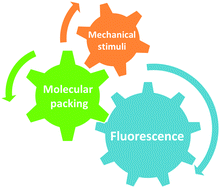
Mater. Chem. Front., 2017,1, 2174-2194
https://doi.org/10.1039/C7QM00201G
3-Piperazinyl propenylidene indolone merocyanines: consecutive three-component synthesis and electronic properties of solid-state luminophores with AIE properties
One-pot insertion-coupling-addition synthesis gives piperazinyl indolones showing aggregation induced emission and crystallization-induced emission enhancement.
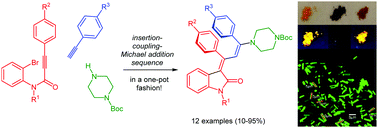
Mater. Chem. Front., 2017,1, 2013-2026
https://doi.org/10.1039/C7QM00198C
Multi-stimuli responsive luminescent azepane-substituted β-diketones and difluoroboron complexes
Multi-stimuli responsive properties were found for azepane-substituted β-diketones and difluoroboron complexes, including solvatochromism, viscochromism, aggregation-induced emission, mechanochromic luminescence and halochromism.
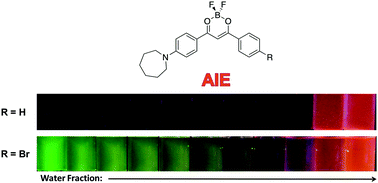
Mater. Chem. Front., 2017,1, 1866-1874
https://doi.org/10.1039/C7QM00137A
Controlling solid-state optical properties of stimuli responsive dimethylamino-substituted dibenzoylmethane materials
Dimethylamino β-diketones with electron donating and withdrawing substituents displayed solvatochromism and aggregation induced emission. In the solid state, a blue to orange color range and thermal and mechanoresponsive properties were achieved.
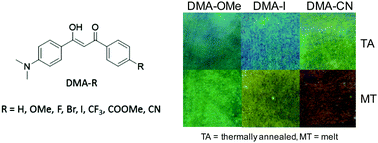
Mater. Chem. Front., 2017,1, 1804-1817
https://doi.org/10.1039/C7QM00157F
A tetraphenylethylene (TPE)-based supra-amphiphilic organoplatinum(II) metallacycle and its self-assembly behaviour
A tetraphenylethylene (TPE)-based supra-amphiphilic organoplatinum(II) metallacycle was successfully prepared, which presented biological application in cell imaging.
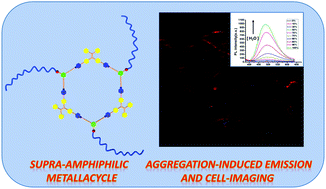
Mater. Chem. Front., 2017,1, 1823-1828
https://doi.org/10.1039/C7QM00107J
Lighting up the interactions between bacteria and surfactants with aggregation-induced emission characteristics
A schematic illustration of the interactions between aggregation-induced emission (AIE)-active surfactants and Gram-negative E. coli.
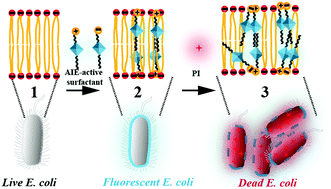
Mater. Chem. Front., 2017,1, 1829-1835
https://doi.org/10.1039/C7QM00125H
Ultrasensitive water sensors based on fluorenone-tetraphenylethene AIE luminogens
Two fluorenone-tetraphenylethene AIE luminogens have been designed and synthesized, which exhibit the ultra-high sensitivity to trace water in organic solvents such as THF or dioxane.
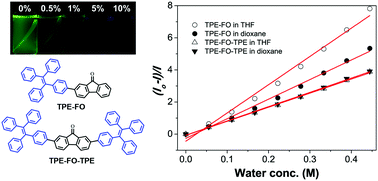
Mater. Chem. Front., 2017,1, 1841-1846
https://doi.org/10.1039/C7QM00172J
Time-evolved, far-red, circularly polarised luminescent polymer aggregates endowed with sacrificial helical Si–Si bond polymers
Non-charged helical polysilanes (PSi) were spontaneously endowed with CPL on the order of gem = ±0.02 at 700 nm when non-helical red- and far-red π-conjugated polymeric (PF8DBT) aggregates were employed after ageing at 20–25 °C for 24 h, followed by PSi-selective photoscissoring at 313 nm for 60 s.
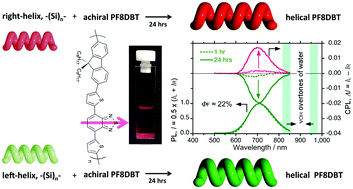
Mater. Chem. Front., 2017,1, 1773-1785
https://doi.org/10.1039/C7QM00096K
A turn-on AIE active fluorescent sensor for Hg2+ by combination of 1,1-bis(2-pyridyl)ethylene and thiophene/bithiophene fragments
1,1-Bis(2-pyridyl)ethylenes with additional thiophene or bithiophene aryl substituents are AIE active compounds that exhibit selective red-shifted chelation enhanced fluorescence (CHEF) in the presence of Hg2+ ions.

Mater. Chem. Front., 2017,1, 1654-1661
https://doi.org/10.1039/C7QM00085E
Control of aggregation-induced emission versus fluorescence aggregation-caused quenching by bond existence at a single site in boron pyridinoiminate complexes
The control of luminescence properties between fluorescence aggregation-caused quenching and aggregation-induced emission with or without a chemical bond at a single site in boron complexes was accomplished.
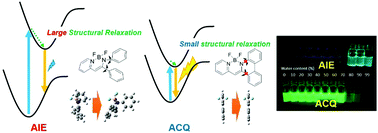
Mater. Chem. Front., 2017,1, 1573-1579
https://doi.org/10.1039/C7QM00076F
Organic molecules with propeller structures for efficient photoacoustic imaging and photothermal ablation of cancer cells
We report organic nanoparticles for efficient photoacoustic imaging and photothermal therapy, based on the small molecule BTPETTQ which has a propeller structure and a donor–acceptor–donor configuration.
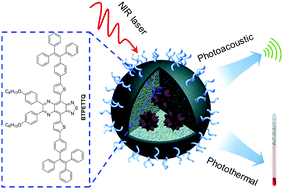
Mater. Chem. Front., 2017,1, 1556-1562
https://doi.org/10.1039/C7QM00056A
Insights into the origin of aggregation enhanced emission of 9,10-distyrylanthracene derivatives
Intramolecular rotation around the vinyl moiety plays an important role in the whole AIE process of DSA derivatives.
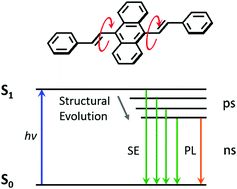
Mater. Chem. Front., 2017,1, 1422-1429
https://doi.org/10.1039/C7QM00032D
Substituent effects on the aggregation-induced emission and two-photon absorption properties of triphenylamine–dibenzo[a,c]phenazine adducts
Non-substituted and alkyl-substituted triphenylamine–dibenzo[a,c]phenazine adducts (Q1–Q3) showed the combined features of ICT plus AEE, while the alkoxy-substituted Q4–Q5 exhibited obvious AIE effects.
![Graphical abstract: Substituent effects on the aggregation-induced emission and two-photon absorption properties of triphenylamine–dibenzo[a,c]phenazine adducts](/en/Image/Get?imageInfo.ImageType=GA&imageInfo.ImageIdentifier.ManuscriptID=C7QM00024C&imageInfo.ImageIdentifier.Year=2017)
Mater. Chem. Front., 2017,1, 1396-1405
https://doi.org/10.1039/C7QM00024C
Red-emitting AIEgen for luminescent solar concentrators
This study reports for the first time the use of a red-emitting AIEgen, i.e. TPE-AC, for the realization of efficient luminescent solar concentrators (LSCs) based on poly(methyl methacrylate) (PMMA) and polycarbonate (PC) thin films (25 ± 5 μm).
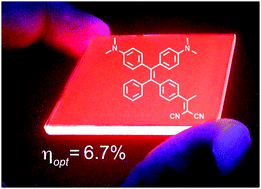
Mater. Chem. Front., 2017,1, 1406-1412
https://doi.org/10.1039/C7QM00008A
Tetraphenylfuran: aggregation-induced emission or aggregation-caused quenching?
Tetraphenylfuran, structurally similar to AIE-active siloles, exhibits the traditional aggregation-caused quenching, which is co-caused by the restriction of intramolecular rotation and the conjugation effect.

Mater. Chem. Front., 2017,1, 1125-1129
https://doi.org/10.1039/C6QM00343E
Luminescent tetraphenylethene-cored, carbazole- and thiophene-based microporous polymer films for the chemosensing of nitroaromatic analytes
Chemically and electrochemically generated novel microporous polymer networks (MPNs) have been prepared from tetraphenylethene (TPE)-cored, multifunctional carbazole- or thiophene-based monomers for the fluorescence sensing of nitroaromatic analytes.

Mater. Chem. Front., 2017,1, 1118-1124
https://doi.org/10.1039/C6QM00281A
A highly selective fluorescent nanoprobe based on AIE and ESIPT for imaging hydrogen sulfide in live cells and zebrafish
An AIE/ESIPT-based nanoprobe has been developed for the specific detection and imaging of H2S in vitro and in vivo.
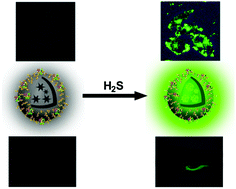
Mater. Chem. Front., 2017,1, 838-845
https://doi.org/10.1039/C6QM00223D
About this collection
Materials Chemistry Frontiers is delighted to publish the following collection of articles on “Aggregation-Induced Emission”.
This web collection is associated with the “The 3rd International Symposium on Aggregation Induced Emission: Materials, Mechanisms and Applications” at ICMAT2017 (18-23 June 2017, Suntec Singapore).
Guest editors Bin Liu (National University of Singapore), Andrea Pucci (University of Pisa), and Thomas Baumgartner (University of Calgary) welcome the most recent research that are dedicated to the development of novel AIE luminogens, exploration of their technological applications and also the deep understanding of AIE mechanisms.